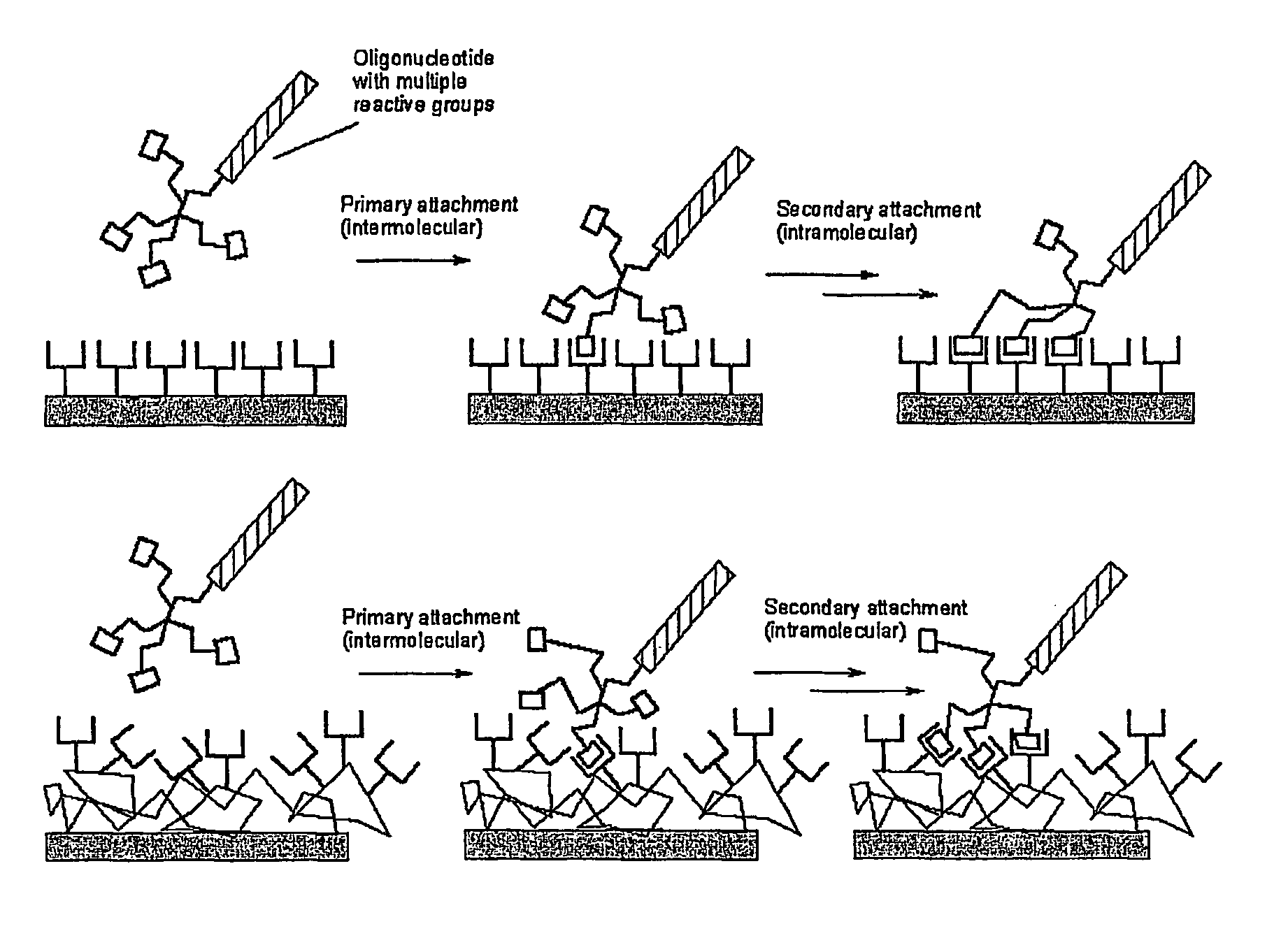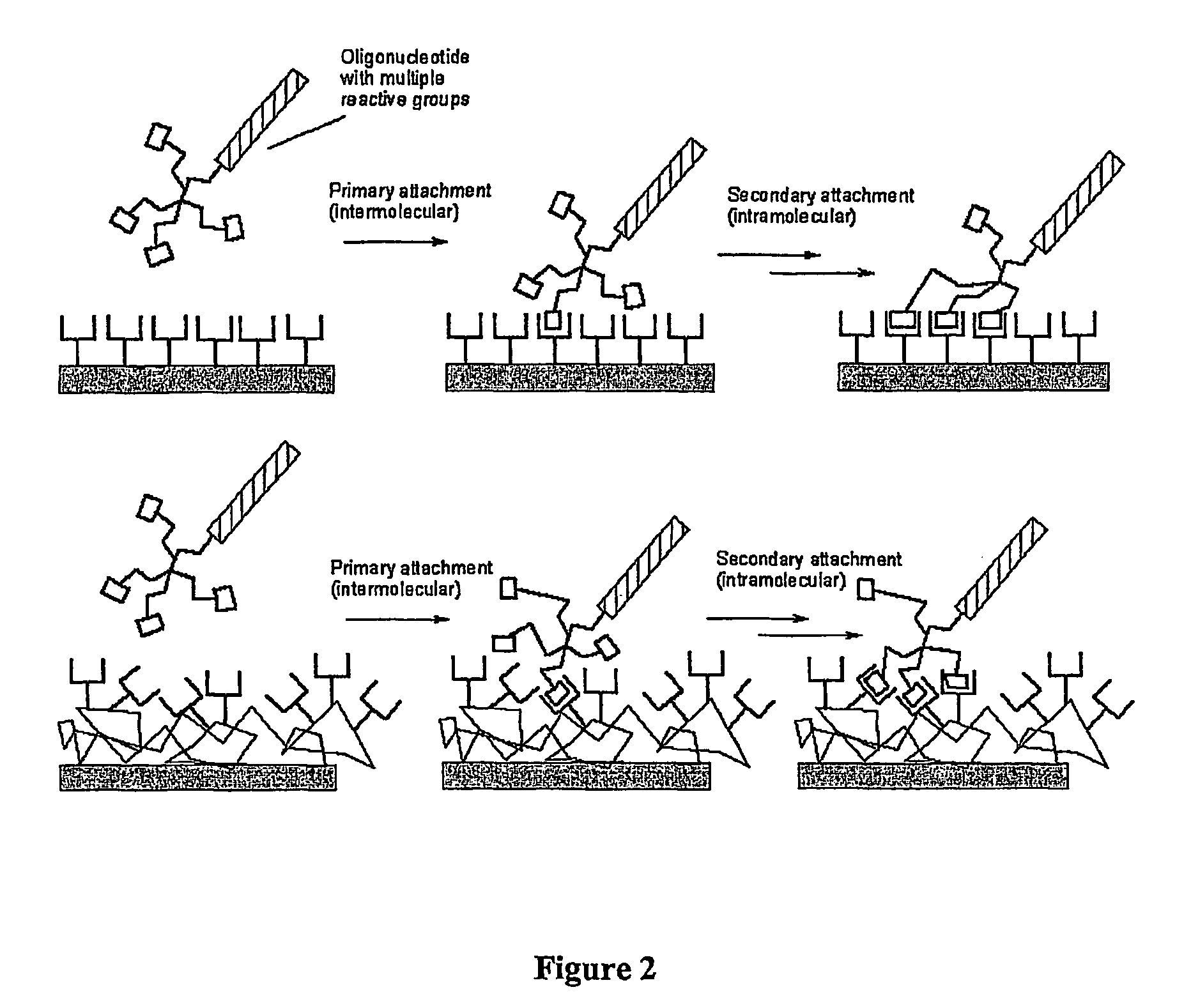Biomolecules having multiple attachment moieties for binding to a substrate surface
a biomolecule and substrate technology, applied in biochemistry apparatus and processes, instruments, organic chemistry, etc., can solve the problems of increasing increasing the stability of the immobilization reaction, and becoming unnecessary, so as to increase the overall stability of the attachment, increase the speed of the immobilization process, and increase the overall stability
- Summary
- Abstract
- Description
- Claims
- Application Information
AI Technical Summary
Benefits of technology
Problems solved by technology
Method used
Image
Examples
example 1
Experiment 1.1
Synthesis of N-Triphenylmethyl-6-hydroxycapronic acid hydrazide, (compound 5, FIG. 9A)
[0066]To a solution of 6.2 g (20 mmol) of tritylhydrazine hydrochloride (3a) in 200 ml of THF was added 2.22 g (22 mmol, 1.1 eq) triethylamine. The solution was stirred at room temperature (rt) for 15 min, filtered, concentrated to afford compound 3, then treated with 2.29 g (20 mmol, 1 eq) of ε-caprolactone (compound 4). The mixture is heated to 65° C. for 5 h the cooled to rt for 18 h. The precipitate was collected and recrystallized from ethyl acetate to afford 3.55 g (45%) of a white powder (compound 5): 1H-NMR 7.49-7.47 (m, 5H), 7.35-7.10 (m, 10H), 6.55 (d, J=7.52, 1H), 5.55 (d, J=7.25, 1H), 3.54 (t, J=6.45, 2H), 1.87 (t, J=7.25, 2H), 1.62 (bs, 1H), 1.57-1.34 (m, 4H), 1.27-1.11 (m, 2H).
experiment 1.2
Synthesis of 6-[(2Cyanoethoxy)(diisopropylamino)phosphanyloxy]-N′-tritylhexanohydrazide (compound 1a, FIG. 9A)
[0067]To a solution of 3.0 g (7.7 mmol) N-triphenylmethyl-6-hydroxycapronic hydrazide (compound 5) in 50 ml dry dichloromethane at rt was slowly added 4.0 g (31 mmol, 4 eq) of N-ethyldiisopropyl amine and 2.01 g (8.5 mmol, 1.1 eq) of chloro(diisopropylamino)-β-cyanoethoxyphosphine (compound 6) over 15 min. Upon complete addition, the reaction was stirred for 1 h, concentrated, and chromatographed (ethyl acetate / n-heptane 2 / 3 with 0.2% triethylamine) to afford 3.19 g (70%) of 1a as a pale yellow foam. 1H-NMR: 7.49-7.46 (m, 5H), 7.34-7.20 (m, 10H), 6.57 (d, J=7.2, 1H), 5.57 (d, J=7.5, 1H), 3.85-3.74 (m, 2H), 3.62-3.48 (m, 4H), 2.62-2.59 (m, 2H), 1.88-1.84 (m, 2H), 1.53-1.33 (m, 4H), 1.27-1.13 (m, 14H); 31P-NMR (CDCl3): δ=147.97.
experiment 1.3
Preparation of Ethyl 6-[(2-cyanoethoxy)(diisoproylamino)phosphanyloxy]hexanoate (compound 1b, FIG. 9B, Scheme 2)
[0068]To a solution of 1.65 g (10 mmol) of ethyl 6-hydroxyhexanoate (compound 7) in 30 ml dichloromethane at rt are slowly added 5.17 g (40 mmol, 4 eq) of N-ethyldiisopropyl amine and 2.6 g (11 mmol, 1.1 eq) of compound 6 over 15 min. Upon complete addition, the reaction was further stirred for 15 min, concentrated, and chromatographed (ethyl acetate / n-heptane ¼ with 0.2% triethylamine) to afford 2.47 g (69%) of compound 1b as clear oil: 1H-NMR 4.12 (q, J=7.25, 2H), 3.90-3.77 (m, 2H), 3.75-3.55 (m, 4H), 2.64 (t, J=6.44, 2H), 2.30 (t, J=7.25, 2H), 1.69-1.59 (m, 4H), 1.44-1.34 (m, 2H), 1.25 (t, J=7.25, 3H), 1.20-1.12 (m, 12H); 31P-NMR (CDCl3): δ=148.01.
PUM
| Property | Measurement | Unit |
|---|---|---|
| current densities | aaaaa | aaaaa |
| pH | aaaaa | aaaaa |
| pH | aaaaa | aaaaa |
Abstract
Description
Claims
Application Information
 Login to View More
Login to View More - R&D
- Intellectual Property
- Life Sciences
- Materials
- Tech Scout
- Unparalleled Data Quality
- Higher Quality Content
- 60% Fewer Hallucinations
Browse by: Latest US Patents, China's latest patents, Technical Efficacy Thesaurus, Application Domain, Technology Topic, Popular Technical Reports.
© 2025 PatSnap. All rights reserved.Legal|Privacy policy|Modern Slavery Act Transparency Statement|Sitemap|About US| Contact US: help@patsnap.com



